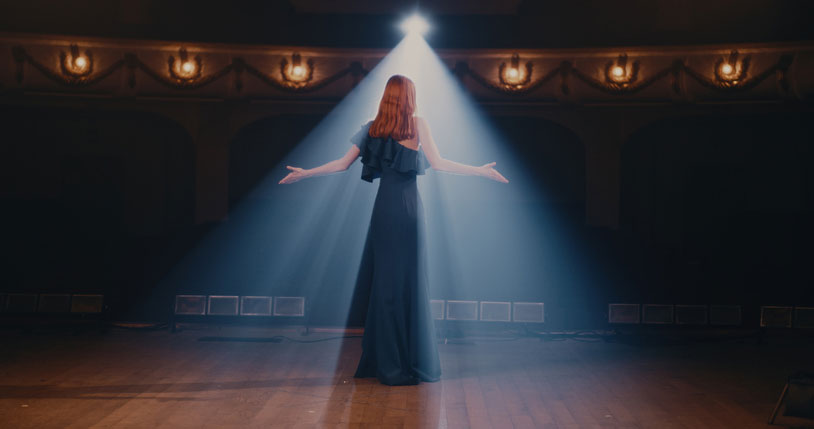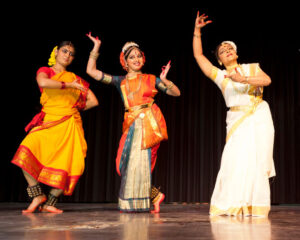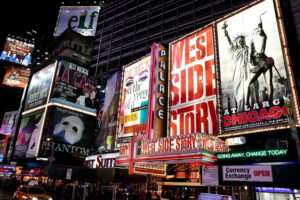

Today, just as in the past, the theater is a place where people can go to get lost in a story. We laugh and cry during a performance; feel pity and scorn towards the characters we see on stage.
Theater provides a creative outlet for people who specialize in lighting, scenery, writing, poetry, music, costumes, choreography, acting, and philosophy. It provides room for expressing the many facets and archetypes of humanity – comedy, tragedy, heroism, romance, irony, and mockery.
The founders of theater, the classical Greeks, knew just as well as any modern theater goer, that comedy is a powerful medium. Understanding how to get a message across to an audience involves everything from an awareness of artistic costume design to skilled political rhetoric that draws on a knowledge of history; all elements that are a foundational part of a liberal arts education.
Theater as a Democratizing Political Tool – A Liberal Arts Commentary
 Elements of theater are distinct from elements of religious ritual, which was almost certainly the predecessor of theater, though both may share some common traits. As an invention of sixth century BC Athens, Aristotle was a contemporary of the first theater and made sure to emphasize that theater was independent of religion.
Elements of theater are distinct from elements of religious ritual, which was almost certainly the predecessor of theater, though both may share some common traits. As an invention of sixth century BC Athens, Aristotle was a contemporary of the first theater and made sure to emphasize that theater was independent of religion.
Today we know theater as an expressive art. Good theater epitomizes human emotions and successfully begs for our empathetic response.
That’s usually not controversial, until it enters the realm of humor. Laughing at power is the first step in de-legitimizing and then challenging it, and that’s why a hallmark of oppressive regimes is to restrict theater:
- The Chinese Communist Party forbids any theatrical representation of Winnie the Pooh because Pooh Bear may symbolize criticism of their leader Xi Jinping.
- Russia passed what critics call an “anti-meme” law that prohibits edited photos of public images from being used out of context.
- Dozens of countries still have laws on the books for lèse-majesté, a French term loosely translated as, “insulting the king.” These include Iceland, Poland, Spain, Switzerland, Saudi Arabia, Turkey, and Thailand.
“Comedy...is a representation of inferior people, not indeed in the full sense of the word bad, but the laughable is a species of the base or ugly. It consists in some blunder or ugliness that does not cause pain or disaster, an obvious example being the comic mask which is ugly and distorted but not painful”.
–Aristotle (384 BC-322 BC)
Women Haven’t Always Been Center Stage in Theater - Achieving Female Empowerment Through a Modern Liberal Arts Perspective
 To say that women have not always been the focus of history is an understatement. In fact, when theater was first invented in Classical Greece, men played the part of women on stage because theater was thought to be too dangerous for women. In that sense even cross-dressing men were on stage before women.
To say that women have not always been the focus of history is an understatement. In fact, when theater was first invented in Classical Greece, men played the part of women on stage because theater was thought to be too dangerous for women. In that sense even cross-dressing men were on stage before women.
The Romans would continue the Greek tradition of excluding women from the stage, and ideas about the chastity of women took root as Christianity spread throughout Europe. It wasn’t until after Shakespeare’s time in 1600s Europe that women finally went on stage there, thanks to a new form of performance known as opera.
This wasn’t without controversy, especially for the Church.
“A beautiful woman who sings on stage and keeps her chastity is like a man who leaps into the Tiber and keeps his feet dry.”
-Pope Clement XI Tweet
In fact, the Church was so incensed that women would go on stage that for centuries it instead opted to use castrated men to sing the higher octaves.
Distinct from Western opera, Chinese Opera is a form of musical theater that emerged in the fourth century AD during the Later Zhao Dynasty and is still performed today. Throughout its history it has featured strong women roles, however it wasn’t until the 20th century that women were allowed to take the stage.
The Evolution of Feminine Archetypes in Theater
 India’s historical view towards women on stage was the polar opposite of the European and Chinese. Theater emerged in India around the same time it did in Athens, making it one of the oldest forms of theater in the world.
India’s historical view towards women on stage was the polar opposite of the European and Chinese. Theater emerged in India around the same time it did in Athens, making it one of the oldest forms of theater in the world.
Sanskrit drama stems from an entire treatise written on the subject by a sage who lived at least 2,200 years ago. Called the Natya Sastra, it outlines eight sentiments that playwrites should use in their scripts, which typically included the stock characters of a hero, heroine, and clown:
- Erotic
- Odious
- Comic
- Pathetic
- Marvelous
- Heroic
- Furious
- Terrible
It describes having good actors as being essential to having a good theatrical performance, and offers extensive guidelines on how both male and female actors can develop their skills. Theater troupes could be mixed sexes, all women, and all men.
The Natya Sastra also had a specific section on women in the performing arts that by modern standards can only be described as sexist in its narrow scope of the feminine archetype. Among other details, it explains: “The 10 natural graces of women are sportive mimicry, amorous gesture, dishabille, confusion, hysterical mood, manifestation of affection, pretended anger, affected coldness, lolling, and want of response.”
The history of theater can shine a light on cultural norms, gender restrictions, and movements for equality. These pieces all fit together in a liberal studies education.
Liberal Studies Breathe New Life Into the Future of Theater
 There’s never been a more exciting time to get into theater than now.
There’s never been a more exciting time to get into theater than now.
It’s easier than ever to collaborate with colleagues, talk with agents, and arrange rehearsals with cast members.
The world is becoming increasingly connected, and that means the ability to incorporate different cultural elements and philosophies from around the globe into cosmopolitan productions. Today there are more tools than ever before in theater’s toolbox for doing things like:
- Making a modern commentary on race, history, and immigration in a production like Lin-Manuel Miranda’s Hamilton.
- Illuminating class, social, and racial tensions in a production like West Side Story, a collaboration between Arthur Laurents, Leonard Berstein, and Stephen Sondheim that was itself inspired by Shakespeare’s Romeo and Juliette.
- Challenging entrenched political systems and groups of privileged people, as Bertolt Brecht did in many of his works.
Theater is special because it combines many elements of the liberal arts –philosophy, cultural diversity, societal equity, performance art, history, politics, and more. Theater evokes an emotional response in the audience that helps us understand the world around us; something that is at the core of what the liberal arts are all about.






